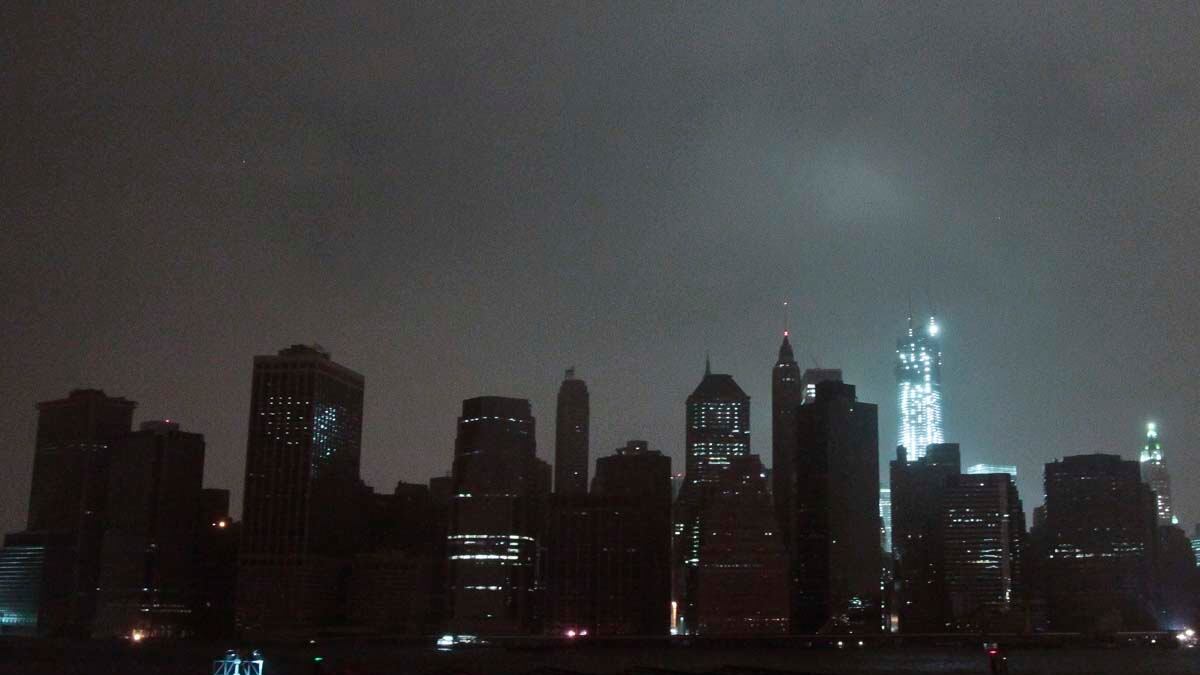When the power goes out in New York, it goes out for everybody. Or almost everybody. As superstorm Sandy took out the region’s electricity transmission and distribution grids Monday night, turning much of Manhattan into an eerie black stretch of horizon, a few bright spots remained. The headquarters of Goldman Sachs—at 200 West Street in submerged lower Manhattan—shone brightly. And throughout the region, in the posh ZIP codes of Greenwich and Scarsdale, Great Neck and Summit, certain mansions glowed like oases in electricity deserts.
Forget the Porsche Cayenne SUV or the Fifth Avenue address: the new status symbol in the gilded communities of the tristate metropolitan area, where wealth is frequently and ostentatiously on display, may be a loud, blocky, unbranded amalgam of metal and plastic that is hidden from view and only comes into play a few days per year: a backup generator.
This week, power literally equals status. Like many financial firms, Goldman invested lots of money in a robust backup power system that kicks into gear whenever the grid goes down. And as disruptive storms like Sandy increase in frequency, backyard generators are becoming an essential part of the haute bourgeois suburban dream.
The power in my home in Westport went out at about 5:30. Connecticut Light & Power, which restores power with the same speed that Prince Fielder rounds the bases, said on Tuesday afternoon that 87 percent of the electricity customers in town were without power. But I am able to file this story because we had our own first responder: the Generac Guardian 10KW backup generator we installed last year. It immediately kicked into gear when the lights went out, and has been humming ever since—powering two home offices, a couple of televisions, a refrigerator, and a microwave, not to mention charging up cellphones for the neighbors.
Elsewhere in town, people in much larger homes are huddling in the cold, searching for candles, and struggling to connect to the outside world. But we’re comfortable, and carrying on as usual.

As with other accoutrements of the high-end lifestyle, not all backup generators are created equal. For example: the equipment has to be powerful enough to carry the load, it must be maintained, and it has to be located in the right place. New York University’s Langone Medical Center, just a few miles north of Goldman’s headquarters, learned that last lesson the hard way when its backup generator, which was located in the hospital’s basement, failed. The hospital was forced to relocate 215 patients, including several newborn babies, in the middle of the night. Gary Cohn, a member of the hospital’s board (and, coincidentally, Goldman’s president), noted that the building’s infrastructure is “not state of the art.” (Hat tip: Andrew Morse of Bloomberg, @morsea)
Until recently, backup generators “seemed to be the purview of the commercial space,” said Jonathan Miller, president of appraisal firm Miller Samuel and an expert on luxury real estate. Typically, they were considered de rigueur only by financial-services firms, health-care companies, and other vital cogs in the economy that can’t abide even a brief interruption in power. “But I wouldn't be surprised if we saw more interest in the introduction of this into residential buildings going forward,” Miller said.

After all, last night’s outages plunged hundreds of thousands of homes throughout the region into darkness—including many worth seven and eight figures. When you’re spending that sort of money on a dwelling, odds are you can afford more than some flashlight batteries and a box of candles.
What’s more, we live in an era in which there is increasingly no divide between the office and home. It’s impossible to run a hedge fund, a small business, or a large company—or to provide consulting, legal, and accounting services—if you can’t charge your smartphone and log on to your work email from a home-based computer. For those in media, or who work regularly with global counterparts, weekends and evenings are mere extensions of the workday.
Nevertheless, the existence of backup generating capacity hasn’t been part of the marketing pitch for high-end apartments in Manhattan—even when it’s included in the price. Fifteen Central Park West, home to a cadre of financial and industrial titans, doesn’t advertise its two 500 KVA onsite gas generators. And One 57, the ultra-high-end building whose construction crane became the source of much drama Monday night, doesn’t mention backup generating capacity.
I’m guessing that will change in the weeks and months to come. After all, what good is a sky palace with a car elevator if you can’t get your Bentley down to the street? What’s the value of a 58th-floor aerie overlooking Central Park if you have to walk up the stairs? “Maybe you hire more-athletic help,” suggested Jonathan Miller.
In fact, savvy real-estate brokers are advising buyers and sellers to place greater emphasis on backup generators. “As an agent, I’m suggesting that buyers put in a generator,” said Laurie Crouse, a veteran broker in Westport, Conn., which is now dotted with darkened million-dollar homes. “For the kind of money that these houses cost, to spend $8,000 or $10,000 on a generator isn’t a significant extra investment.” For a home that she recently sold for $2 million, Crouse advised the builder to add a generator as a selling point. “I’m not seeing it as standard yet, which is staggering to me,” said Crouse, who was speaking from her home. Her cellphone, perhaps the most vital tool for a real-estate broker, was fully charged—thanks to the generator she recently installed.
Indeed, the rising incidence of power outages is changing the suburban view of status. It used to be all about finishes and brand names—Sub-Zero refrigerators, Viking ranges, three-car garages, an indoor pool. But all those toys and amenities are useless without electricity. In times like these, infrastructure suddenly becomes an object of desire.






